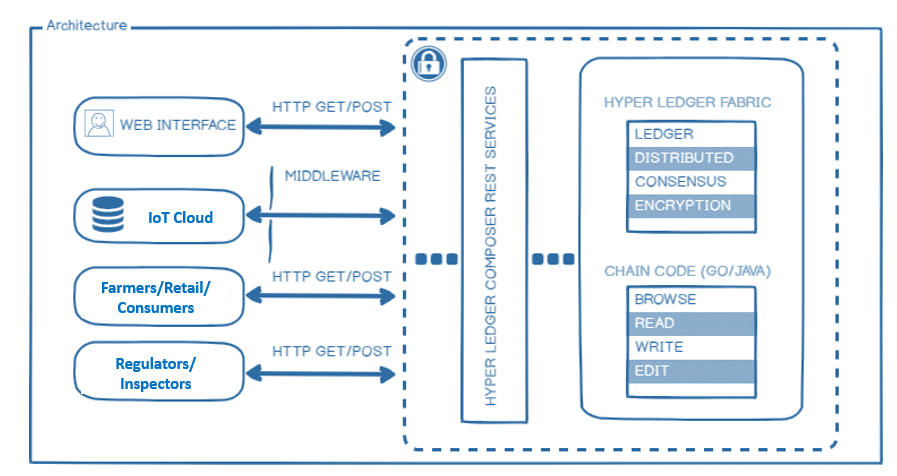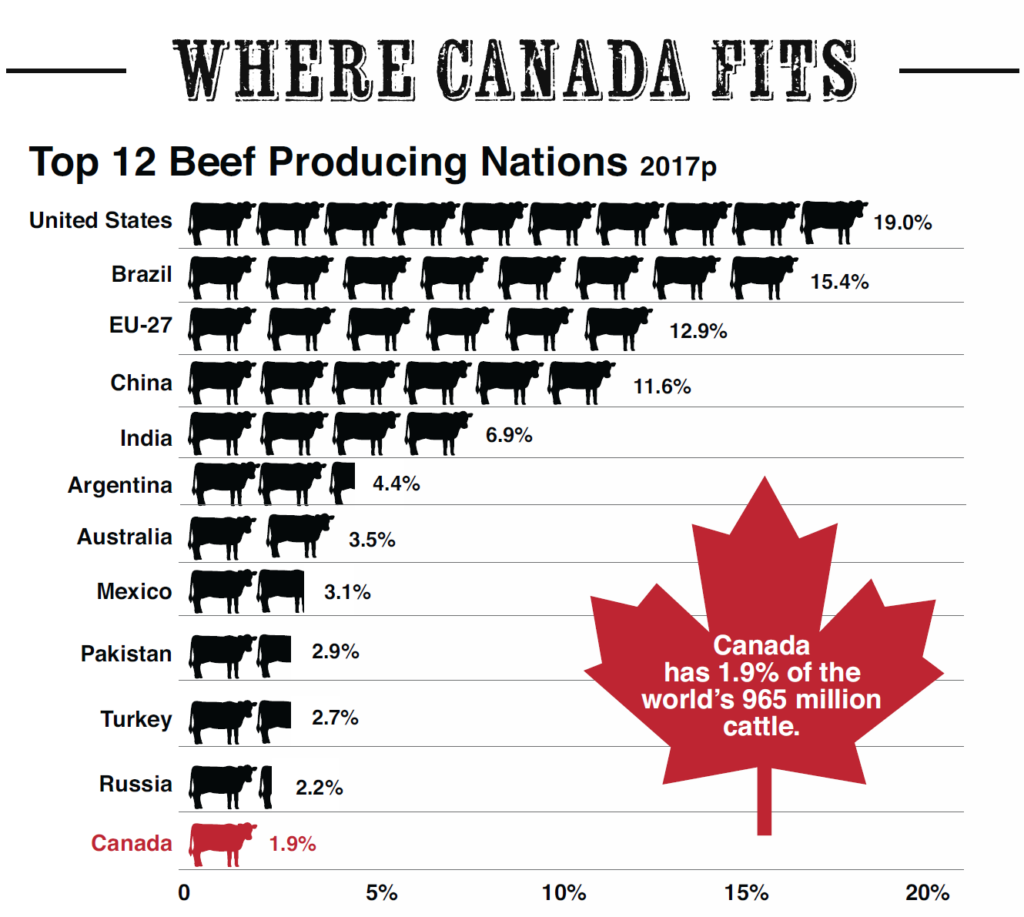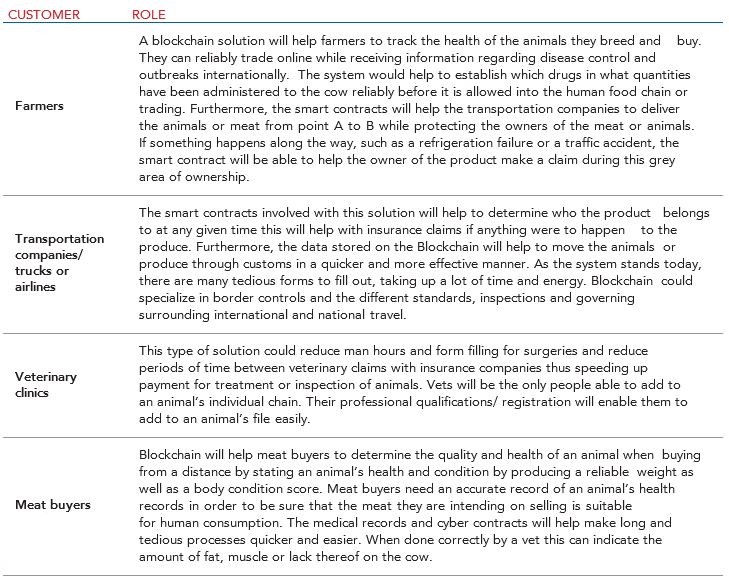INTRODUCTION Beef is one of the biggest meat products consumed globally, and the world consumed 129.5 billion pounds of beef in 2016. Managing these kind of consumption volumes requires collaboration between Cattle farmers, slaughtering and meat processing plants, transportation and logistics, freight forwarders, veterinary physicians, insurance companies, airport handling, and regulatory agencies. As health awareness amongst the general population is increasing, there is more and more demand for transparency and visibility into how the animal has been raised, how the animal was treated medically, how the animal was slaughtered and how the meat was processed and handled under different environment conditions all the way from the slaughter house to the grocery store, or as steak on your table in the restaurant! The current beef export market and supply is riddled with major problems, such as lack of traceability of the beef back to the birth farm, poor transparency, price volatility, non-compliance to export laws, poor quality control standards, absence of traceability in transactions and poor correlation between cost and quality of the product. The following diagram illustrates the high-level steps in the meat export chain.

There are three different ways to consider the problem: 1. The problems farmers face with buying and selling livestock. The first problem is faced at the beginning of a cow’s life. This is a time where an animal may need medical attention and may be given drugs. In this case these drugs need to be carefully monitored and recorded as so they don’t enter the supply chain. Without this information a cow cannot be slaughtered and processed for human consumption. 2. The problems faced with meat importation and exportation The second problem faced is a problem because different countries have different rules and regulations governing meet imports or exports. This causes great confusion and there are many forms, documents and regulatory bodies involved in making this process happen. The process is also labor intensive and slow, making it a necessary but expensive exercise. 3. Food traceability The third problem is food traceability. When a customer is buying a product from the shelf they have no way of knowing where that meat has come from, how long it has taken to get there, or how ethically it was sourced and raised. Sure, there are organic meats on the market however many of the cattle involved in the beef industry only need to be out for two weeks to be classed as free range and drug free for a short period of time before that are classed as organic. The customer needs a way of knowing and understanding exactly where a product has come from and its history. BLOCKCHAIN SOLUTION To solve the above-mentioned problems, I propose a blockchain solution. The solution at its core will use a distributed, decentralized immutable ledger to store all the information about an animal from birth to its final state (to a store or to a restaurant). The immutable nature of the ledger ensures that the data collected throughout the animal’s value chain cannot be tampered with, and in addition, at any point of the value chain, the transactional information within the block helps us identify the true ownership of the animal. Blockchain is more than the next viral buzzword. Blockchain technology provides a feasible solution to some of the biggest problems that supply chains currently face such as lack of transparency and accountability, by providing a solution that can enable the transfer of titles of goods, recording of permissions and activity logs as well as real time data updates using internet enabled devices, thereby eliminating the need to reconcile and minimizing errors across complex value chains. Digital Tokens can be attached to intermediate goods as they progress through the supply chain, while smart contracts enable automatic payments to respective parties based on delivery of goods, and also ensure that vendors and employees along the supply chain are carrying out the necessary checks and balances to ensure the quality of the product. One of the biggest advantages of the Blockchain network is that it is able to anonymize data except to the participants with the right amount of access. This is critical in terms of protecting farmers by not giving away the farmers location to the general population while providing health information, but at the same time providing this sensitive information to required stakeholders like Centre for Disease Control (CDC) if there is a disease outbreak. ARCHITECTURE The blockchain solution could be a permissioned network built on Hyperledger framework. Hyperledger Fabric can be a preferred solution as we have specific identifies for all our participants and the architecture of Hyperledger easily enables the permissioned network for known identities and associates specific levels of access to each of the participants. This means that participants can only view and update the data that they have access to and will not see all of the transactions within a block. Moreover, instead of having to create static identities for each participant into our solution, Hyperledger also enables “Bring your own Identity” which is key to our use case where the entities in the supply chain may be constantly changing and already have existing identity management systems.

Hyperledger is also much more scalable than its counterparts as it is built on a modular architecture that separates the chaincode from the transaction validation portion, decreasing the processing time and energy utilized for consensus. The architecture also enables a “pluggable consensus” which means that the consensus mechanism is decoupled from the participants who are involved in the actual maintenance of the ledger improving performance and in addition enabling a variety of consensus mechanism options from BFT (Byzantine Fault Tolerance) to the more CPU intensive PoS (Proof of Stake). MARKET ANALYSIS AND TARGET CUSTOMERS Canada is one of the world’s largest global exporters of red meat. On average Canada is the 12th highest producer of beef globally. January 2017 statistics as stated by Statistics Canada suggest that in 2016 Canada produced 1.9 percent of the world’s beef supply exporting 360 million kilograms and importing 186 million kilograms of beef in total, thus contributing on average 16 billion dollars to Canada’s GDP (Gross Domestic Product) between 2012 and 2016. Furthermore, Canadian exports were valued at 2.23 billion dollars in 2015 and grew by another 2 percent in 2016 to 2.27 billion dollars. The image below illustrates some Canadian trade routes and depicts where Canada fits in the global market (Source: 2017 Statistics Canada).


Beef is slaughtered in one of two ways - The cows are either sent directly to the slaughter house by the farmer or are sent to market and bought by a “meat” or “kill” buyer. If a farmer decides to slaughter their cattle directly a meat buyer will buy the meat from them directly. Depending on the grading of the beef the farmer will be paid per kg of meat or deadweight. This is usually slightly higher than if a buyer buys a cow as live weight because the animal is heavier when it has all of its organs and bones. Having said this, this is a farmer’s preferred way of slaughter as it’s a more reliable way of guaranteeing a consistent and regular price for your meat as it eliminates the extraneous variables of beef grading and dead weight outcomes. Extraneous variables play a huge part in the beef industry and a lot hinges on unknowns. A blockchain solution plans on helping its customers to eliminate some of the unknown variables to more reliably trade and track meat. This will help the farmers, buyers, sellers and handlers anywhere in the chain There are seven different target segments involved (as stakeholders


CONCLUSION With an industry as prominent in Canada as beef production, implementing a blockchain solution to the supply chain can significantly improve processes around buying and selling, importing and exporting, and food traceability. The solution at its core will use a distributed, decentralised immutable ledger to store all the information about an animal from birth to its final state (to a store or to a restaurant). The immutable nature of the ledger ensures that the data collected throughout the animal’s value chain cannot be tampered with, and in addition, at any point of the value chain, the transactional information within the block helps us identify the true ownership of the animal. All these benefits create a strong argument for implementing a blockchain solution in the beef supply chain. REFERENCES BEEF2LIVE.COM/STORY-WORLD-BEEF-CONSUMPTION-PER-CAPITA-RANKING-COUNTRIES-0-111634 BEEFRESEARCH.ORG/CMDOCS/BEEFRESEARCH/BEEF%20GRADING.PDF NCBI.NLM.NIH.GOV/PMC/ARTICLES/PMC4006171/ WORLDSTOPEXPORTS.COM/TOP-BEEF-EXPORTING-COUNTRIES/ CATTLE.CA/CCA-RESOURCES/INDUSTRY-STATS
